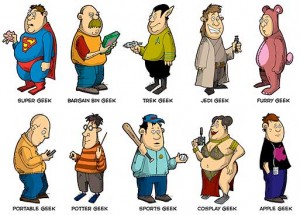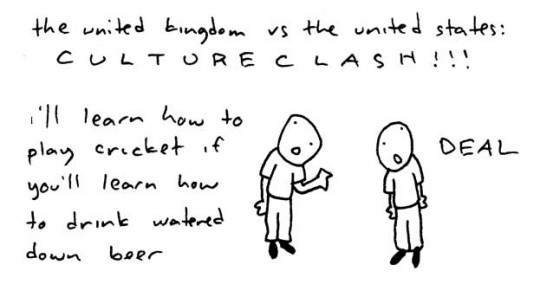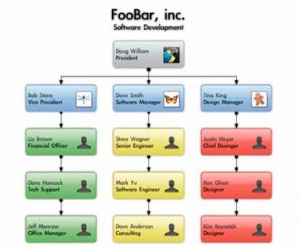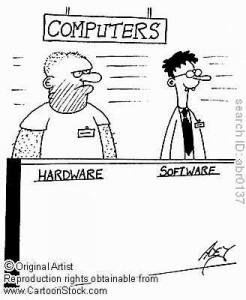Last time I explored some of the reasons why we as IT folk tend to stick together. I also talked a bit about how culture can both allow you to thrive with your own kind, but also fail to see some of the obvious problems around you because of the cultural blinders effect. In this segment, I’ll talk a bit about why this is actually pretty important to be aware of, and how they can manifest.

If you look at the occupational grouping, IT the club has a whole lot of cultural characteristics. In a 2004 study, Jeffrey Stanton of Syracuse University surveyed the overall culture when looking at how IT initiatives may fail in organizations because of IT subculture issues.
His team found that IT people in 80 companies used common modes of communication symbolism. This stressed the unwillingness of computer users to learn certain things, and a common belief in the cluelessness of end users and the “set apart status” of IT.
They also displayed ethnocentric attitudes: these implied that their group was both important and different from others, that they possessed esoteric knowledge, that they perceived themselves as having extreme working conditions, and having many complaints about other groups.
So we, as a whole, are a smart, fairly obnoxious group of folk who hang out together.

But this is not unusual; even though IT folk seem to have a stronger, more distinct cultural identity, most segmentations show signs of this. EVERYONE thinks they’re the most important piece of the puzzle. If you’ve ever worked at a newspaper you know how the journalists all say, “We are the newspaper; we create the product,” and the graphic folk say, “We actually make the newspaper, put it together, and get it done,” and the sales people say, “We are the newspaper; if we didn’t sell ads none of you people would have jobs” – The truth, however, is that a newspaper could not exist unless all the divisions were doing their job; they just can’t see it.
Annoying at times, but… why should anyone care?
Why should you care?
Whenever two cultures or sub-cultures have different sets of assumptions and world-views, and these ground rather than object, a train-wreck is going to happen (big or small, but it’ll involve you somehow). There will be costs, frustration, stress, and worse relationships with the kind of useful people who provide the resources and environment, which make work worthwhile.

The problem might be called lack of collaboration, poor communication, bad scoping, scope creep, revision work, IT arrogance, loose cannons in IT, etc., but somewhere it will come down to culture clash.
Let’s examine an occupational culture: While we are generally blind to the big differences of culture, we are often sensitive to the small differences of subcultures (a Tampa resident can often tell you the exact differences between New Tampa and South Tampa culture).

At the top of our IT pyramid, we have the suits – business types who manage IT processes and liaise a lot with the admin, accounting, marketing, C-suite, engineering, etc., types from the rest of the business world. Below them, we have people who do the work. (Suits don’t do the work?). The Suit subculture is more hierarchical and rule-bound than Those Who Do the Work.
Leaving the Suits, let’s look at the sub-culture of the Doers, Nerds, Geeks, etc.
Let’s also borrow some terms from the thinking toolbox of Anthropoly (here’s the app – CultureGPS). It’s always easier to have a name for something, because it creates a thinking tool. This culture is more:
- particularist (we will not live by regulations and we don’t like bureaucratic, one-size-fits-all rules)
- polychonic: (time flows: multitasking is normal and 8:30 – 5pm doesn’t exist)
- low power distance: (equality is the norm, people with power do not assert it, and others in the culture do not tolerate power-posturing)
- diffuse: life is less compartmentalized: both work and relationships flow through the roles and space that Those-Who-Do-The-Work inhabit.
You can drill down further. Those-Who-Do-The-Work have small sub-cultures. Are you a software or a hardware specialist? One sub-culture (software) tolerates more emotion and has a greater emphasis on humor than the other.

Within the software group, you can drill down further. At the top of the “ain’t-it-cool” guys we have games developers. If software culture is elitist, creative, individualist, what about games development? The development culture is already insular, because only another developer truly understands the beauty of your underappreciated algorithm, but within gaming you find an intense version of this.
The massive skills of the unappreciated genius, whose mathematical and physics skills translate into the perfection of a blood splatter or a exact buoyancy of a semi-sinking object…

Now surface… back up, up, to the developer and suit, opposite the intimidated or bewildered client, discussing the application.
Those small sub-cultural differences are now magnified enormously, yet they are now almost invisible. And they have the (easy) potential to screw up your project, or the user adoption of your system, changes, etc.
Next post, I’ll try and look at solving this problem of IT culture and maybe even one or two ways we can think about playing nice with others… or I might just go get a beer.
This is Part 2 of a three part series, and you can find the others here in Part 1 and Part 3.